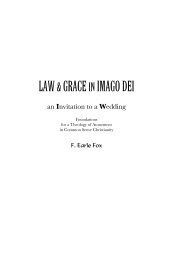Download entire 232-page book HERE (PDF ... - MassResistance
Download entire 232-page book HERE (PDF ... - MassResistance
Download entire 232-page book HERE (PDF ... - MassResistance
You also want an ePaper? Increase the reach of your titles
YUMPU automatically turns print PDFs into web optimized ePapers that Google loves.
The Big Questions<br />
Unit One: Two Ways of Looking at You<br />
When you think about your future, what questions do you ask? Why am I here? Where am I going?<br />
What kind of experiences will I have?<br />
Right now, the answers to these questions probably seem out of reach, unknowable. But the fact is,<br />
you can determine some of those answers today, simply by the choices you make. This mini-course<br />
was created to help you make the best choices. To do that, you need information about the “big<br />
picture,” that is, the way the world looks when you have more of the facts than you do now. Our<br />
hope is that you will gain a new, more informed, perspective on that world from working through<br />
this course and making its information part of your life.<br />
Some of the ideas you will meet here are challenging. They will take time and careful thought to<br />
understand and apply to yourself, your relationships (friends, family, teachers, co-workers) and the<br />
way you live. If you will contribute that time and thought, you will find that the effort earns you big<br />
rewards in terms of your future happiness and the satisfaction you get from life. So let’s get started,<br />
and by the way, we wish you a long and happy life!<br />
Looking at you as a member of a group<br />
One of the most important sets of information that you can learn in life is information about how the<br />
people around you see things. How, for example, would someone you had never met before look at<br />
you? What prejudices would they have? What expectations?<br />
In this country today, there are two main ways of looking at people. One way is to see each person<br />
separately, as a unique and complete individual. The other way is to see people as members of<br />
groups. This second way is described in the chart below. On the left side is a list of the kinds of<br />
groups that people are commonly divided into. On the right are the kinds of characteristics that<br />
people have which allow them to be placed in a particular group.<br />
You will notice that each of the categories listed below is based upon things like race which have equal<br />
value. The value of one is no better or worse than the value of any other: For example, being white<br />
is not better than being black, and being Asian is not better than being Native American because there<br />
is no racial or ethnic “measuring stick” that can be used to decide that these different groups have<br />
different value.<br />
This is the reason that racism is wrong: it places different values on groups which are equal by nature.<br />
You probably wouldn’t like it if people made judgments or decisions about you based on your<br />
membership in a group that is supposed to be equal with other groups of the same type. If they<br />
Redeeming the Rainbow 186






